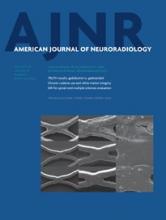Research ArticleHead & Neck
Open Access
MRI Texture Analysis Predicts p53 Status in Head and Neck Squamous Cell Carcinoma
M. Dang, J.T. Lysack, T. Wu, T.W. Matthews, S.P. Chandarana, N.T. Brockton, P. Bose, G. Bansal, H. Cheng, J.R. Mitchell and J.C. Dort
American Journal of Neuroradiology January 2015, 36 (1) 166-170; DOI: https://doi.org/10.3174/ajnr.A4110
M. Dang
bDepartment of Radiology (M.D., J.T.L.), University of Calgary, Calgary, Alberta, Canada
J.T. Lysack
bDepartment of Radiology (M.D., J.T.L.), University of Calgary, Calgary, Alberta, Canada
T. Wu
eSchool of Computing, Informatics, Decision Systems Engineering (G.B., T.W.), Arizona State University, Tempe, Arizona.
T.W. Matthews
aFrom the Section of Otolaryngology–Head and Neck Surgery (T.W.M., S.P.C., P.B., J.C.D.)
S.P. Chandarana
aFrom the Section of Otolaryngology–Head and Neck Surgery (T.W.M., S.P.C., P.B., J.C.D.)
N.T. Brockton
dDepartment of Population Health Research (N.T.B.), Alberta Health Services, Calgary, Alberta, Canada
P. Bose
aFrom the Section of Otolaryngology–Head and Neck Surgery (T.W.M., S.P.C., P.B., J.C.D.)
G. Bansal
eSchool of Computing, Informatics, Decision Systems Engineering (G.B., T.W.), Arizona State University, Tempe, Arizona.
H. Cheng
cDepartment of Radiology (H.C., J.R.M.), Mayo Clinic College of Medicine, Scottsdale, Arizona
J.R. Mitchell
cDepartment of Radiology (H.C., J.R.M.), Mayo Clinic College of Medicine, Scottsdale, Arizona
J.C. Dort
aFrom the Section of Otolaryngology–Head and Neck Surgery (T.W.M., S.P.C., P.B., J.C.D.)

References
- 1.↵
- Parkin DM,
- Bray F,
- Ferlay J, et al
- 2.↵
- 3.↵
American Joint Committee on Cancer. Cancer Staging Handbook: From the AJCC Cancer Staging Manual. Berlin: Springer-Verlag; 2010
- 4.↵
- 5.↵
- Lane DP
- 6.↵
- Levine AJ,
- Momand J,
- Finlay CA
- 7.↵
- Levine AJ,
- Perry ME,
- Chang A, et al
- 8.↵
- Hollstein M,
- Sidransky D,
- Vogelstein B, et al
- 9.↵
- 10.↵
- 11.↵
- Smith EM,
- Wang D,
- Rubenstein LM, et al
- 12.↵
- Soussi T,
- Béroud C
- 13.↵
- Poeta ML,
- Manola J,
- Goldwasser MA, et al
- 14.↵
- Skinner HD,
- Sandulache VC,
- Ow TJ, et al
- 15.↵
- 16.↵
- 17.↵
- 18.↵
- 19.↵
- Mahmoud-Ghoneim D,
- Toussaint G,
- Constans JM, et al
- 20.↵
- Zhang Y
- 21.↵
- Chang CW,
- Ho CC,
- Chen JH
- 22.↵
- 23.↵
- 24.↵
- 25.↵
- Brown R,
- Zlatescu M,
- Sijben A, et al
- 26.↵
- Eoli M,
- Menghi F,
- Bruzzone MG, et al
- 27.↵
- Levner I,
- Drabycz S,
- Roldan G, et al
- 28.↵
- Drabycz S,
- Stockwell RG,
- Mitchell JR
- 29.↵
- 30.↵
NeoLogica. DICOM Anonymizer Pro. http://www.neologica.it/eng/DICOMAnonymPro.php. Accessed September 12, 2012.
- 31.↵
- Cheng CH,
- Mitchell JR
- 32.↵
- Frank E,
- Hall M,
- Trigg L, et al
- 33.↵
- Gutlein M,
- Frank E,
- Hall M, et al
- 34.↵
- Cheng J,
- Greiner R
- 35.↵
- Heckerman D
- 36.↵
- Hruschka ER Jr.,
- Hruschka ER,
- Ebecken NF
- 37.↵
- 38.↵
- 39.↵
- 40.↵
- 41.↵
- Guo R,
- Li Q,
- Meng L, et al
- 42.↵
- Riedel F,
- Götte K,
- Schwalb J, et al
- 43.↵
- Uchida S,
- Shimada Y,
- Watanabe G, et al
- 44.↵
In this issue
American Journal of Neuroradiology
Vol. 36, Issue 1
1 Jan 2015
Advertisement
M. Dang, J.T. Lysack, T. Wu, T.W. Matthews, S.P. Chandarana, N.T. Brockton, P. Bose, G. Bansal, H. Cheng, J.R. Mitchell, J.C. Dort
MRI Texture Analysis Predicts p53 Status in Head and Neck Squamous Cell Carcinoma
American Journal of Neuroradiology Jan 2015, 36 (1) 166-170; DOI: 10.3174/ajnr.A4110
0 Responses
Jump to section
Related Articles
- No related articles found.
Cited By...
- Prediction of Tumor Grade and Nodal Status in Oropharyngeal and Oral Cavity Squamous-cell Carcinoma Using a Radiomic Approach
- MRI texture analysis as a predictor of tumor recurrence or progression in patients with clinically non-functioning pituitary adenomas
- Additional Clinical Value for PET/MRI in Oncology: Moving Beyond Simple Diagnosis
- MRI-Based Texture Analysis to Differentiate Sinonasal Squamous Cell Carcinoma from Inverted Papilloma
This article has been cited by the following articles in journals that are participating in Crossref Cited-by Linking.
- Reza Forghani, Avishek Chatterjee, Caroline Reinhold, Almudena Pérez-Lara, Griselda Romero-Sanchez, Yoshiko Ueno, Maryam Bayat, James W. M. Alexander, Lynda Kadi, Jeffrey Chankowsky, Jan Seuntjens, Behzad ForghaniEuropean Radiology 2019 29 11
- Fei Yang, Nesrin Dogan, Radka Stoyanova, John Chetley FordPhysica Medica 2018 50
- Yiming Li, Zenghui Qian, Kaibin Xu, Kai Wang, Xing Fan, Shaowu Li, Tao Jiang, Xing Liu, Yinyan WangNeuroImage: Clinical 2018 17
- John Ford, Nesrin Dogan, Lori Young, Fei YangContrast Media & Molecular Imaging 2018 2018
- Amit Jethanandani, Timothy A. Lin, Stefania Volpe, Hesham Elhalawani, Abdallah S. R. Mohamed, Pei Yang, Clifton D. FullerFrontiers in Oncology 2018 8
- Matthew Seidler, Behzad Forghani, Caroline Reinhold, Almudena Pérez-Lara, Griselda Romero-Sanchez, Nikesh Muthukrishnan, Julian L. Wichmann, Gabriel Melki, Eugene Yu, Reza ForghaniComputational and Structural Biotechnology Journal 2019 17
- Eiman Al Ajmi, Behzad Forghani, Caroline Reinhold, Maryam Bayat, Reza ForghaniEuropean Radiology 2018 28 6
- Steven W. Mes, Floris H. P. van Velden, Boris Peltenburg, Carel F. W. Peeters, Dennis E. te Beest, Mark A. van de Wiel, Joost Mekke, Doriene C. Mulder, Roland M. Martens, Jonas A. Castelijns, Frank A. Pameijer, Remco de Bree, Ronald Boellaard, C. René Leemans, Ruud H. Brakenhoff, Pim de GraafEuropean Radiology 2020 30 11
- Noriyuki Fujima, Akihiro Homma, Taisuke Harada, Yukie Shimizu, Khin Khin Tha, Satoshi Kano, Takatsugu Mizumachi, Ruijiang Li, Kohsuke Kudo, Hiroki ShiratoCancer Imaging 2019 19 1
- Valeria Romeo, Simone Maurea, Renato Cuocolo, Mario Petretta, Pier Paolo Mainenti, Francesco Verde, Milena Coppola, Serena Dell'Aversana, Arturo BrunettiJournal of Magnetic Resonance Imaging 2018 48 1
More in this TOC Section
Similar Articles
Advertisement











